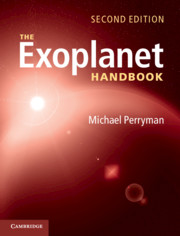Book contents
- Frontmatter
- Contents
- Preface to the Second Edition
- 1 Introduction
- 2 Radial velocities
- 3 Astrometry
- 4 Timing
- 5 Microlensing
- 6 Transits
- 7 Imaging
- 8 Host stars
- 9 Brown dwarfs and free-floating planets
- 10 Formation and evolution
- 11 Interiors and atmospheres
- 12 The solar system
- Appendix A Numerical quantities
- Appendix B Notation and acronyms
- Appendix C Radial velocity exoplanets
- Appendix D Transiting exoplanets
- Appendix E Lensing exoplanets
- Appendix F Imaging exoplanets
- References
- Subject index
- Object index
Preface to the Second Edition
Published online by Cambridge University Press: 25 August 2018
- Frontmatter
- Contents
- Preface to the Second Edition
- 1 Introduction
- 2 Radial velocities
- 3 Astrometry
- 4 Timing
- 5 Microlensing
- 6 Transits
- 7 Imaging
- 8 Host stars
- 9 Brown dwarfs and free-floating planets
- 10 Formation and evolution
- 11 Interiors and atmospheres
- 12 The solar system
- Appendix A Numerical quantities
- Appendix B Notation and acronyms
- Appendix C Radial velocity exoplanets
- Appendix D Transiting exoplanets
- Appendix E Lensing exoplanets
- Appendix F Imaging exoplanets
- References
- Subject index
- Object index
Summary
Almost 20 years ago, with the subject still in its infancy, and the number of known exoplanets at just 34, I prepared a 60-page review of exoplanet research (Perryman, 2000). The first edition of the Exoplanet Handbook, published in early 2011, grew out of this: a booklength review to the end of 2010, when the number of known planets was just over 500. The aimof both was to collect in one place a synthesis of the knowledge of the many areas of exoplanet research.
Since then progress has continued to flourish. The number of known exoplanets now exceeds 3500, and the research literature stands at more than 17 000 refereed papers. My goal in this second edition remains the same: to collect in one place, and in unified form, an overall perspective of the many areas of ongoing research, and to provide a synthesis of the developments, discoveries, and associated physical phenomena, with pointers to the more detailed literature. It offers a framework for understanding thewider and more definitive research literature, through to the end of 2017.
Amongst many revisions, and a few minor suppressions, there are extensive additions: I have included the numerous advances in radial velocity, microlensing, imaging (notably SPHERE, GPI, and ALMA), and transit instruments. The latter includes the important and growing class of bright star transiting systems from HATNet, SuperWASP, and others, as well as the transformational results from the Kepler mission. I have also added more on progress in quantifying habitability and the search for life, and associated considerations such as the anthropic principle, SETI and the Fermi paradox, and many related aspects of solar system research.
Much progress has also been made on the theoretical side. Amongst these are advances in the understanding of possible formation pathways via the hypothesised mechanism of pebble accretion; of the formation and dynamical state of multi-planet systems especially in connection with resonance capture; of numerous applications of tidal theory; of the widespread application of atmospheric general circulation models (originally developed for understanding the climate of the Earth and the other solar system planets); and of the development of migrationmodels for the early solar system with their considerable explanatory and predictive content.
- Type
- Chapter
- Information
- The Exoplanet Handbook , pp. xix - xxPublisher: Cambridge University PressPrint publication year: 2018



